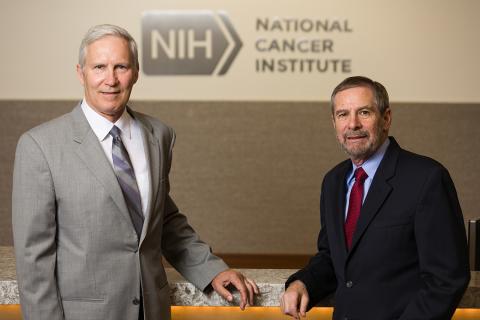Two NCI Scientists Win 2017 Lasker Award

Beginning their partnership as bench researchers in the 1980s, Dr. Doug Lowy and Dr. John T. Schiller have worked together at the National Cancer Institute for more than 30 years. Three decades, more than 150 co-authored papers and hundreds of thousands of prevented cancers later, the pair have received one of the most prestigious scientific achievement awards in the world—a Lasker.
They received the 2017 Lasker~DeBakey Clinical Medical Research Award on Sept. 15 in recognition of research that led to the development of the human papillomavirus (HPV) vaccine. Often referred to as “America’s Nobel,” the Lasker is the nation’s highest honor for biomedical research and one of the most renowned scientific awards in the world.
The road to this award started in the 1990s, when Lowy and Schiller began investigating ways to prevent cancers caused by HPV. Ten years earlier, Dr. Harold zur Hausen and his team discovered that infection with certain types of HPV causes almost all cases of cervical cancer—the fourth most common cancer in women worldwide. Each year, more than 500,000 women around the world are diagnosed with cervical cancer and more than 275,000 women die from the disease. HPV infection was also found to cause anal, vulvar, vaginal, penile and oropharyngeal cancers.
Building on zur Hausen’s work, Schiller and Lowy discovered that the proteins that form the outer shell of HPV could form virus-like particles (VLPs) that closely resemble the original virus but are not infectious or oncogenic. They found that VLPs could trigger the immune system to produce high levels of protective antibodies that can neutralize the virus in a subsequent infection. The VLPs ultimately became the basis of the three current HPV vaccines: Gardasil, Gardasil 9 and Cervarix.
The vaccine is a public health triumph and has the potential to eliminate cervical cancer and other HPV-associated cancers as a major public health problem. However, moving this discovery from the laboratory to a commercial vaccine had its challenges; realizing its potential will require concerted efforts to increase vaccine uptake, particularly in low- and middle-income countries where most HPV-associated cancers occur.
“The vaccine manufacturers took a considerable risk in their role in developing the vaccine,” said Lowy. “Before the HPV vaccine, there was no vaccine that could prevent benign and malignant disease that develops at the initial site of infection. Fortunately for everyone, the ability of the commercial vaccines to prevent disease caused by HPV has exceeded even our most optimistic expectations.”
The vaccine also highlights the importance of basic research in the development of medical breakthroughs.
“Basic discovery is the engine of translational research,” said Schiller. “Virtually every single one of the major advances in modern biomedicine are based on fundamental discoveries. It’s not clear which basic discoveries are going to lead to which medical breakthroughs. Although we’re receiving this award, it really is an award that should go to the whole community of brilliant and hardworking NCI, academic and industry scientists. Without all of their efforts, we wouldn’t have this vaccine.”
